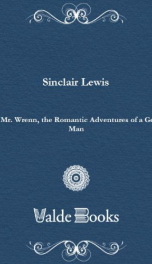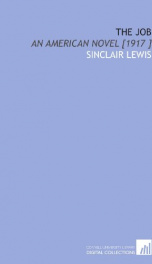Lewis Sinclair

Harry Sinclair Lewis (February 7, 1885 – January 10, 1951) was an American novelist, short-story writer, and playwright. In 1930, he became the first American to be awarded the Nobel Prize in Literature, "for his vigorous and graphic art of description and his ability to create, with wit and humor, new types of characters." His works are known for their insightful and critical views of American society and capitalist values, as well as their strong characterizations of modern working women. Born in the village of Sauk Centre, Minnesota, Lewis began reading books at a young age and kept a diary. He had two siblings, Fred (born 1875) and Claude (born 1878). His father, Edwin J. Lewis, was a physician and, at home, a stern disciplinarian who had difficulty relating to his sensitive, unathletic third son. Lewis's mother, Emma Kermott Lewis, died in 1891. The following year, Edwin Lewis married Isabel Warner, whose company young Lewis apparently enjoyed. Throughout his lonely boyhood, the ungainly Lewis — tall, extremely thin, stricken with acne and somewhat popeyed — had trouble gaining friends and pined after various local girls. At the age of 13, he unsuccessfully ran away from home, wanting to become a drummer boy in the Spanish-American War.[1] In late 1902, Lewis left home for a year at Oberlin Academy (the then-preparatory department of Oberlin College) to qualify for acceptance by Yale University. While at Oberlin, he developed a religious enthusiasm that waxed and waned for much of his remaining teenage years. He entered Yale in 1903 but did not receive his bachelor's degree until 1908, having taken time off to work at Helicon Home Colony, Upton Sinclair's cooperative-living colony in Englewood, New Jersey, and to travel to Panama. Lewis's unprepossessing looks, "fresh" country manners, and seemingly self-important loquacity did not make it any easier for him to win and keep friends at Oberlin or Yale than in Sauk Centre. Some of his crueler Yale classmates joked "that he was the only man in New Haven who could fart out of his face". Nevertheless, he did manage to initiate a few relatively long-lived friendships among students and professors, some of whom recognized his promise as a writer.[2] Lewis's earliest published creative work—romantic poetry and short sketches—appeared in the Yale Courant and the Yale Literary Magazine, of which he became an editor. After his graduation from Yale, Lewis moved from job to job and from place to place in an effort to make ends meet, write fiction for publication, and chase away boredom. While working for newspapers and publishing houses (and for a time at the Carmel-by-the-Sea, California writers' colony), he developed a facility for turning out shallow, popular stories that were purchased by a variety of magazines. At this time, he also earned money by selling plots to Jack London, including the plot for London's unfinished novel The Assassination Bureau, Ltd. Lewis's first published book was Hike and the Aeroplane, a Tom Swift-style potboiler that appeared in 1912 under the pseudonym Tom Graham. In 1914 he married Grace Livingston Hegger, who was an editor at Vogue magazine. His first serious novel, Our Mr. Wrenn: The Romantic Adventures of a Gentle Man, appeared in 1914, followed by The Trail of the Hawk: A Comedy of the Seriousness of Life (1915) and The Job (1917). That same year also saw the publication of another potboiler, The Innocents: A Story for Lovers, an expanded version of a serial story that had originally appeared in Woman's Home Companion. Free Air, another refurbished serial story, was published in 1919. Upon moving to Washington, D.C., Lewis devoted himself to his writing. As early as 1916, Lewis began taking notes for a realistic novel about small-town life. Work on that novel continued through mid-1920, when he completed Main Street which was published on October 23, 1920.[3] As his biographer Mark Schorer wrote, the phenomenal success of Main Street "was the most sensational event in twentieth-century American publishing history."[4] Based on sales of his prior books, Lewis's most optimistic projection was a sale of 25,000 copies. In the first six months of 1921 alone, Main Street sold 180,000 copies, and within a few years sales were estimated at two million.[5] According to Richard Lingeman, "Main Street earned Sinclair Lewis about three million current [2002] dollars". He followed up this first great success with Babbitt (1922), a novel that satirized the American commercial culture and boosterism. The story was set in the fictional Zenith, Winnemac, a setting Lewis would return to in future novels, including Gideon Planish and Dodsworth. Lewis's success in the 1920s continued with Arrowsmith (1925), a novel about an idealistic doctor; it was awarded the Pulitzer Prize (which he refused); the 1931 Hollywood screen adaptation, directed by John Ford and starring Ronald Colman, was nominated for four Academy Awards. Elmer Gantry (1927), which depicted evangelicalism as hypocritical, was denounced by religious leaders and banned in some U.S. cities; it too was adapted for the screen in 1960, earning Burt Lancaster a Best Actor Oscar for his performance. Lewis divorced his first wife, Grace Hegger Lewis, in 1925, and married Dorothy Thompson, a political newspaper columnist, on May 14, 1928. Together they had a son in 1930, actor Michael Lewis, but they divorced in 1942. Lewis closed out the decade with Dodsworth (1929), a novel about the most affluent and successful members of American society leading essentially pointless lives in spite of their great wealth and advantages. The book was adapted for the Broadway stage in 1934 by Sidney Howard, who also scripted the 1936 film version, directed by William Wyler. The film was a great success and is still highly regarded—in 1990, it was selected for preservation in the United States National Film Registry and in 2005 Time magazine named it one of the 100 best movies of the past 80 years[6]. Lewis also spent much of the late 1920s and 1930s writing short stories for various magazines and publications. One of his short stories published in Cosmopolitan magazine was "Little Bear Bongo" (1936), a tale about a bear cub who wanted to escape the circus in search of a better life in the real world.[7] The story was acquired by Walt Disney Pictures in 1940 for a possible feature film. World War II sidetracked those plans until 1947, when the story (now titled "Bongo") was placed on a shorter length as a part of the Disney feature Fun and Fancy Free. In 1930, Lewis won the Nobel Prize in Literature in his first year of nomination. In the Swedish Academy's presentation speech, special attention was paid to Babbitt. In his Nobel Lecture, he praised Theodore Dreiser, Willa Cather, Ernest Hemingway, and other contemporaries, but also lamented that "in America most of us — not readers alone, but even writers — are still afraid of any literature which is not a glorification of everything American, a glorification of our faults as well as our virtues," and that America is "the most contradictory, the most depressing, the most stirring, of any land in the world today." After winning the Nobel Prize, Lewis published nine more novels in his lifetime, the best remembered being It Can't Happen Here, a novel about the election of a fascist U.S. President. He was married to Dorothy Thompson until 1942, but the marriage effectively ended in 1937. Lewis died in Rome on January 10, 1951, aged 65, from advanced alcoholism and his cremated remains were buried in Sauk Centre. A final novel, World So Wide, was published posthumously. Grazia Deledda (1926) · Henri Bergson (1927) · Sigrid Undset (1928) · Thomas Mann (1929) · Sinclair Lewis (1930) · Erik Axel Karlfeldt (1931) · John Galsworthy (1932) · Ivan Bunin (1933) · Luigi Pirandello (1934) · Eugene O'Neill (1936) · Roger Martin du Gard (1937) · Pearl S. Buck (1938) · Frans Eemil Sillanpää (1939) · Johannes Vilhelm Jensen (1944) · Gabriela Mistral (1945) · Hermann Hesse (1946) · André Gide (1947) · T. S. Eliot (1948) · William Faulkner (1949) · Bertrand Russell (1950)
do you like this author?
What readers are saying
What do you think? Write your own comment on this book!
write a commentWhat readers are saying
What do you think? Write your own comment on this author!
write a commentBook list

The Trail of the HawkA Comedy of the Seriousness of Life
Series:
Unknown
Year:
Unknown
Raiting:
4/5
Show more
add to favoritesadd In favorites
Book list

The Trail of the HawkA Comedy of the Seriousness of Life
Series:
Unknown
Year:
Unknown
Raiting:
4/5
Show more
add to favoritesadd In favorites

The Trail of the Hawk
Series:
Unknown
Year:
Unknown
Raiting:
2.5/5
1915 novel by Harry Sinclair Lewis, an American novelist, short-story writer, and playwright of the twentieth century. The story follows a career of a person, coming from lower part of the society, who tries to carve his way in life. The usual conflict between a man and society, appearing the main motive contradiction of the Lewis’ literary work, is treated here as a non-social problem. The development of this contradiction is presented in “The Trail of the Hawk” in special clue, through the exotic of travels.
Show more
add to favoritesadd In favorites

Our Mr. Wrenn, the Romantic Adventures of a Gentle Man
Series:
Unknown
Year:
Unknown
Raiting:
3/5
Our Mr. Wrenn, the Romantic Adventures of a Gentle Man is the first novel created by Sinclair Lewis. It appeared for the first time in 1914 and immediately draw attention from readers and literary critics. The plot of novel focuses on William Wrenn who is divorced and who lives and works in New York saving money for a trip to India or Java. One day he gives up his work and sails to Liverpool. For a couple of weeks Wrenn travels throughout England enjoying its beautiful landscapes. In London he meets an art student Istra Nash with whom they start playing. And what kind of game is that, you will see further when reading this fabulous novel.
Show more
add to favoritesadd In favorites

The Job
Series:
Unknown
Year:
Unknown
Raiting:
4/5
One of the best early works of Harry Sinclair Lewis, an American novelist, short-story writer, and playwright of the 19th-20th centuries. This novel, a story of one of numerous American women making a career by hard longstanding work, stands apart from his other writings of that period. It is considered an early declaration of the rights of working women. The story takes place in the early 1900-1920's and takes Una, the protagonist, from a small Pennsylvania town to New York, where she struggles to achieve the same status of her male coworkers.
Show more
add to favoritesadd In favorites

Free Air
Series:
Unknown
Year:
Unknown
Raiting:
4.5/5
Free Air is one of the most outstanding examples of classic American literature that was originally published in 1919. This novel is written in classical American style and is devoted to the opportunities of traveling and trips that appeared with the appearance of the first automobiles. The novel will keep everyone very attentive and smiling when reading it.
Show more
add to favoritesadd In favorites
What readers are saying
What do you think? Write your own comment on this author!
write a commentif you like Lewis Sinclair try:
readers also enjoyed
What readers are saying
What do you think? Write your own comment on this author!
write a commentGenre
if you like Lewis Sinclair try:
readers also enjoyed
Do you want to exchange books? It’s EASY!
Get registered and find other users who want to give their favourite books to good hands!

